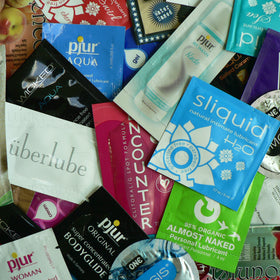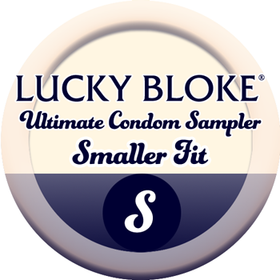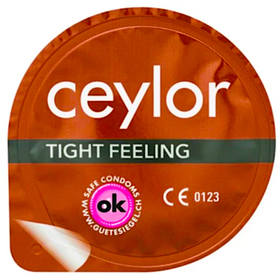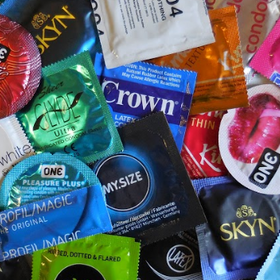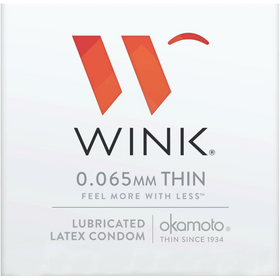7 Reasons Female Condoms Are Actually Amazing & When They Offer Great Pleasure Over A Traditional Condom
Female condoms often get a bad wrap (yes, pun intended).
Truth be told, we prefer the term “internal” condoms, since these barrier condoms are useful to folks of all genders. You’ve probably heard them called female condoms — assuming you’ve heard of them at all.
Since so few people are familiar with them, it begs the questions:
What exactly are they?
Who are they for, men, women, both?
What sex acts are more pleasurable with an internal condom?
And if female condoms are such a good option, why aren’t more people using them?
We asked Allison Moon, a sex educator and author at GirlSex101.com, to break it down for us.
“Internal condoms are thin, plastic barriers that go inside the orifice that will be penetrated,” she explains. More specifically, they’re inserted into the anus or vagina. “[They] protect against pregnancy, fluid exchange, and skin-to-skin transmitted STIs.”
This form of protection might is admittedly less popular than its external counterpart, but don’t be fooled — female condoms might seem a little mysterious at first, but they’re still worth trying. It may be a little different from the condom you unrolled onto a banana in health class, but there are benefits to female condoms that other forms of protection can’t touch.
Skeptical? We get it. Allow us to give you a friendly introduction to female condoms (or, like we prefer, “internal” condoms). You might be surprised by what you learn.
-
Female condoms can actually make sex even safer than external ones.
Internal condoms cover more surface area, reducing the amount of skin-to-skin contact. That makes them an excellent form of protection against STIs. And because the receiving partner can insert it at any time, they don’t have to worry about whether or not the penetrating partner will comply and actually use a condom.
As a result, there are less likely to be any “oops” moments if things get hot and heavy and neither partner wants to slow down — you’re protected right from the beginning.-
You don’t have to wait for a penis to be erect before you can use them.
Part of why external condoms can be tricky is because by the time you’re able to use them, it’s likely you and your partner are already aroused. This inevitably means pausing in the middle of a sexy moment to reach for the condom and roll it on — and if an erection is lost, it can slow things down even further.
Using external condoms correctly is so important in theory, but not always fun in practice. It’s one of the big complaints you’ll often hear about them.
Female condoms are awesome in this regard, because there’s no waiting game. Either partner can insert it before things get sexy (or at any point you’d like), and when all systems are go, penetration can happen right away.
If you don’t like to slow down once the engines are revved up, internal condoms are a great option for everyone involved.
-
They're a great alternative for people with latex allergies or latex sensitivity.
Most female condoms currently on the market are made of a type of rubber called nitrile. Nitrile is thinner than regular condoms (although at LB we have lots of thin options) and provides a great alternative for people who want something different than their traditional condom but haven't found anything that works with their latex allergy.
One interesting fact is that nitrile is same material used in rubber gloves. The sames ones your doc uses for latex sensitive patients in the office. Be sure to check the label if you're looking for a latex alternative because not all products are the same, but this one is definitely available for latex sensitive folks.
-
They’re a one-size-fits-all form of protection.
According to Men’s Health, many men continue to struggle with finding the right size condom. If an external condom is too loose or too snug, you risk having that condom slip, slide off, or fail entirely. And if it does, it’s not exactly doing you a whole lot of good.
Female condoms, however, really are a “one-size-fits-all” form of protection, Moon says. You don’t have to fret about an internal condom being too big or too small.And if you or your partner happen to be insecure about size, there’s no need to buy those jumbo condoms just for appearances (which, let’s be real, is a terrible idea).
-
They’re not complicated to use — in fact, they can be easier to use than external condoms.
There’s a misconception that female condoms aren’t user-friendly. However, that’s not actually the case.
“Internal condoms are often easier to use, because they don’t require as much dexterity as rolling a condom down an erect penis,” Moon explains. “It’s simply a manner of opening the package, and feeding the condom inside the anus or vagina with your fingers.”
And because either partner can insert them at any time, there’s a lot more flexibility about how and when you bring them into play. If you pop into the bathroom to “freshen up” before getting busy, you can even insert it discreetly, without having to worry about whether or not there’s a condom within reach on the nightstand.
In fact, one surprising fact is that an internal condom can actually be inserted 4-6 hours before being put to use.
-
They’re more likely to stay put because of how they’re designed.
While an external condom can roll or slip off of a penis, especially if an erection is lost, internal condoms stay put regardless.
“Because internal condoms aren’t dependent on erect penises, they can help protect during sex even when a person has a hard time maintaining and erection or doesn’t like the sensation of external condoms,” Moon says.
With external condoms, it’s also much easier to make a mistake while pulling out. If users forget to hold the base of an external condom when doing so, this can lead to a loose condom slipping off the penis entirely. This can lead to spillage, introducing fluids (like semen) into the vagina or anus, creating a much greater risk of pregnancy or sexually-transmitted infections.
You can avoid that mess entirely, though, with a simple switch to female condoms.
-
They’re not just for vaginal sex.
“Because for so long they’ve been called ‘female condoms,’ many people didn’t realize you can use them effectively in the anus, and regardless of gender,” Moon says. If anal play is your thing, this is good news. Unlike external condoms, which need to be removed promptly after intercourse, internal condom users are free to decide when they remove theirs.
“They’re particularly great for anal sex, because they can stay put even after sex is over,” Moon explains. “So for folks worried about mess, internal condoms can help preserve the afterglow while you wait until you’re ready to remove it.”
Female condoms deserve way more credit than they get, since they’re incredibly useful and often a better option than external condoms. That’s also why we prefer the term “internal” condom — they’re not just for vaginas, either. Regardless of your gender or orientation, it’s likely that internal condoms could be useful to you.
Intrigued? We thought so. At Lucky Bloke, we’ve got you covered. Our Pasante brand Female Condom is a game-changer — particularly if that game involves some amazing lube. With a little practice, female condoms can be a great addition to your safer sex arsenal.


